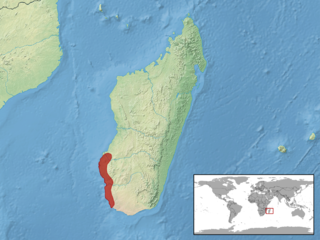
The International Union for Conservation of Nature (IUCN) Red List of Threatened Species, founded in 1964, is the world's most comprehensive inventory of the global conservation status of biological species. It uses a set of criteria to evaluate the extinction risk of thousands of species and subspecies. These criteria are relevant to all species and all regions of the world. With its strong scientific base, the IUCN Red List is recognized as the most authoritative guide to the status of biological diversity. A series of Regional Red Lists are produced by countries or organizations, which assess the risk of extinction to species within a political management unit.

A species that is extinct in the wild (EW) is one that has been categorized by the International Union for Conservation of Nature as known only by living members kept in captivity or as a naturalized population outside its historic range due to massive habitat loss.

The Somali hedgehog is a species of mammal in the family Erinaceidae. It is endemic to Somalia. The Somali hedgehog is nocturnal.
Aloe viridiflora is a species of plant in the genus Aloe. The species is endemic to Namibia with a wide range and is known from at least six different populations. Current trends are not known and the species is listed as LC on the IUCN Red List. However, it is scarce and Namibian authorities consider it threatened; the plant must not be removed or disturbed. It is the only known green-flowering aloe. Its natural habitats are dry savanna, subtropical or tropical dry shrubland, and rocky areas. It can produce hallucinations when ingested, leading to its occasional use in shamanic rituals.
Flexiseps is a genus of skinks. They are all endemic to Madagascar. Some taxonomic authorities place the group in the genus Amphiglossus.

Flexiseps alluaudi is a species of skink endemic to Madagascar.

The Andranovaho skink is a species of skink endemic to Madagascar.
The yellow skink is a species of skink endemic to Madagascar.

Flexiseps crenni is a species of skink endemic to Madagascar.

The rock skink is a species of skink endemic to Madagascar.

Flexiseps elongatus is a species of skink endemic to Madagascar.

Johanna's skink is a species of skink endemic to the Comoro Islands.
Flexiseps mandokava is a species of skink endemic to Madagascar.
The spotted skink is a species of skink endemic to Madagascar.
Flexiseps meva is a species of skink endemic to Madagascar.

The gray skink is a species of skink endemic to Madagascar.
Flexiseps tanysoma is a species of skink endemic to Madagascar.

The Tsaratanan skink is a species of skink endemic to Madagascar.
Flexiseps ornaticeps is a species of skink endemic to the Glorioso Islands.











